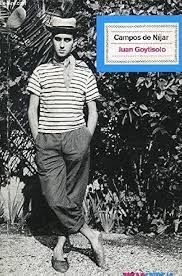
Idioma original: castellano
Year of publication: 1960
Valuation: Recommendable
Juan Goytisolo is one of those great masters of the middle of the last century, a member of the small group of authors (I am not going to cite anyone else so that they do not criticize me) that all lovers of literature should know in depth. In fact, I have to confess that I don’t know any more than some of the most representative titles of his narrative work, an unforgivable lack that I try to begin to correct, a little at random, with this his first travel book, written when Goytisolo had not yet arrived. completely detached from its realistic and rather low-risk beginnings.
The journey is very little epic and much more about exploration. The author, who is in his twenties, older than the little boy on the cover seems to look, seems to know something of the terrain beforehand, and seeks total immersion. Let us remember, we are in Spain at the end of the 1950s, still burdened by a decade of autarky and for the most part without shedding the rags of centuries of poverty, backwardness and lack of culture, especially in the deepest rural areas. And the setting is perhaps one of the most extreme that the traveler could look for: the region east of Almería, sometimes inland (Níjar), and other times looking at the coast (Cabo de Gata, Rodalquilar, Agua Amarga, Carboneras) . In between, desolate fields, tiny towns, deserted roads or paths, African landscapes, dwarf or non-existent vegetation under a scorching sun.
Some or many of these places are now charming small towns or tourist destinations with attractive, urbanized and cosmopolitan although relatively quiet chalets. But seventy years ago, a somewhat extravagant French tourist barely appeared from time to time, and the closure of some mines had left depopulation and very poor villages where the objective was pure survival. It seems that Goytisolo, whom the neighbors look at as an alien because he comes from Barcelona, is nevertheless looking for the soul of the region, and he is finding it in those people who look out of the doors, the half-naked children who surround him, or the countrymen who give him conversation in the tavern.
He travels by bus, in the back of a truck or in a cart pulled by a donkey, he stays in the few inns he finds, and he lets the locals talk, the young truck driver, the gentleman who owns an entire town (a character very Berlanga), the civilian couple, the old man who sells prickly pear fruits. Come on, what defines the traveler and differentiates him from the tourist, letting himself go, zero comforts, seeing and listening, recording what surrounds him without filters, in a natural state.
Unlike other travel books, there is no hint of humor, probably because there is no occasion, nor of artificial exaltation. At most, it can be said that Goytisolo, in addition to leaving an almost notarial record of what he sees, carries out a certain style exercise on his story, allowing his prose to be enriched with a perhaps excessively verbose lexicon (guadapero, serillo, cenacho, algaida o Jábega are some terms found on a random page). But it’s not fair to criticize him too much for it either. He is a young author, still dominated by realism, who seems to be looking for a way to progress in his technique. Fortunately he would later find that direction, quite different from this one.
All in all, it leaves some interesting reflections that transcend the landscape or its inhabitants. The author believes he has found the key to a land that should resist the temptation of feeling like a postcard or a museum piece:
‘That’s why I like Almería. Because it doesn’t have Giralda or Alhambra. Because he does not try to cover himself with clothing or decorations. Because it is a naked and true land.’
Something that Carlos Cano would surely have signed, who portrayed those lands in a beautiful pasodoble. Times have changed a lot, but it wouldn’t hurt to give the idea a try, not just in Andalusia, but anywhere else.
Other works by Juan Goytisolo reviewed in ULAD: Hallmarks, Don Julián / Juan sin Tierra, The virtues of the solitary bird
Source: https://unlibroaldia.blogspot.com/2024/06/juan-goytisolo-campos-de-nijar.html


